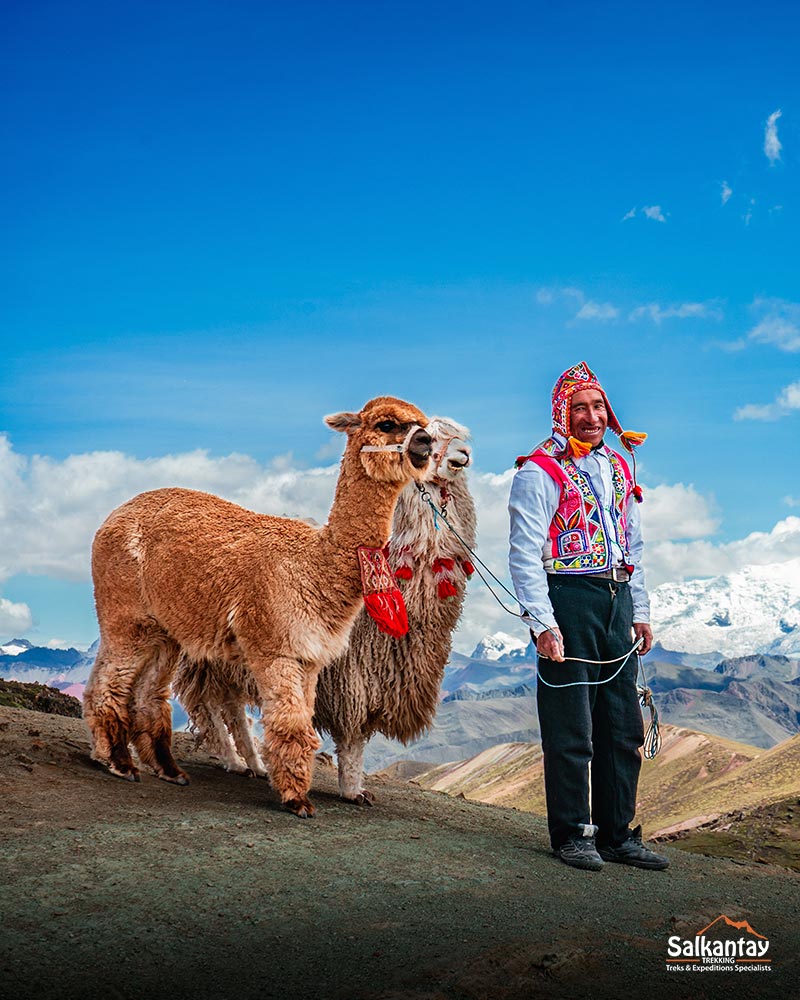Meet the Most Famous Animals of Peru: Llamas, Alpacas, Vicuñas, and Guanacos.
If Cusco is your next travel destination, get ready to see these animals everywhere, peacefully grazing in the mountains.
These camelid species are native to South America and are mainly found in Peru, Bolivia, Chile, and Argentina. Adapted to high altitudes, their true home is the Andes highlands. They’re even known as guardians of the Apus and the sacred mountains of the region.
Many travelers and visitors often confuse them at first glance, especially llamas and alpacas. It’s true that these animals share some similarities, so it’s perfectly normal not to tell them apart if you’re unfamiliar.But don’t worry—we’ll help you recognize them like a true local!
The Llama
Llamas have been inseparable companions of the Andean people for centuries. As far back as the Inca Empire, they were part of daily life, and even today, it’s common to see them wandering among the ruins of Machu Picchu.

- Appearance: Llamas have a strong body and a long neck. They also have elongated faces and ears, which is a very distinctive trait and a key feature to differentiate them from alpacas. Their thick fur can vary in color or even combine several shades, including browns, whites, blacks, and grays.
- Size: Llamas are the largest of the domesticated camelids, standing about 1.7 to 1.8 meters tall (5.7 to 5.9 feet) and weighing between 115 and 180 kg (249 to 397 pounds).
- Use: In addition to being used as transport animals, llama wool is valued for its durability and moderate softness. It is used to make textiles and warm garments.
- Fiber: Llama fiber is thicker and less soft than alpaca fiber, but it is still prized for its strength and durability.
- Behavior: Llamas are domesticated camelids primarily used as transportation animals in the mountainous regions of South America. They are known for being more independent—or even a bit moody—but they can be trained to carry loads over long distances.
Why Do Llamas Spit? 🦙💦 You’ve probably seen those funny videos where a llama launches a surprise spit attack. But don’t be fooled—they don’t do it for fun! Spitting is their way of defending themselves when they feel uncomfortable, threatened, or like their space is being invaded. It’s a last resort for them, but if you bother them… get ready for the legendary llama spit! Always approach them with kindness and respect.
Fun Fact! There are two types of llamas: Q’ara and Chaku. Although they look very similar, the Chaku llama has longer wool compared to the Q’ara, which has shorter and thinner fur.

The Alpaca
With their soft fleece and sweet gaze, alpacas are one of the most iconic animals of the Andes. You’ll often see them around Cusco, especially along high-altitude routes like Ausangate and Rainbow Mountain.

- Appearance: Alpacas have a more compact body and a small, round, and fluffy head, along with short, rounded ears. Their wool is curly, fluffy, and very soft. It comes in many colors, including white, black, brown, and shades of gray. Unlike llamas, alpacas usually have one solid color instead of a mix of tones.
- Size: Alpacas are smaller than llamas. They measure between 1.20 and 1.50 meters tall (3.9 to 4.9 feet) and weigh between 50 and 85 kilograms (110 to 187 pounds).
- Use: Alpacas are extremely important for the local economy, especially in rural areas. Their wool is considered one of the finest in the world. It’s used to make high-quality textiles like sweaters, scarves, blankets, and luxury clothing.
On the other hand, alpaca meat is a true delicacy. Rich in protein, low in fat, and with minimal cholesterol, it’s a healthy and highly valued option in Peruvian and Andean cuisine. - Fiber: Alpaca fiber is soft, warm, and lightweight. It naturally comes in earthy, autumn-like tones. The wool is prized for its softness, warmth, and durability. The most valuable wool comes from baby alpacas, known as baby alpaca or royal alpaca.
- Behavior: Alpacas are domesticated animals raised mainly for their high-quality wool. They are gentler than llamas and easier to manage, making them ideal to raise in larger groups.
Meet the Hippie Alpaca! There are also two types of alpacas: Huacaya and Suri. The Suri alpaca is known for its long, silky hair that hangs in locks—almost like a curtain of fringes. With its unique and bohemian style, it looks like it just walked out of an Andean music festival! This type of alpaca is less common, so if you spot one… consider yourself lucky!


The Vicuña
Unlike llamas and alpacas, vicuñas and guanacos are wild camelids. Today, they are protected species, and hunting them is strictly prohibited under Peruvian law.

- Appearance: Vicuñas are the most delicate and elegant of the camelids, with a slender body and long legs. They have long, soft fur that is golden brown on the back and white on the belly and face.
- Size: Vicuñas are smaller than alpacas and llamas, standing about 1 to 1.20 meters tall (3.3 to 3.9 feet) and weighing between 35 and 55 kilograms (77 to 121 pounds).
- Use: Their main use is for producing high-end textiles. Vicuña wool is considered one of the finest fibers in the world, and products made from it can be extremely expensive.
- Fiber: Vicuña fiber is the finest in the world—extremely luxurious and pricey. Thanks to conservation efforts and strict laws, its collection is done sustainably and under control, only once a year.
- Behavior: Vicuñas are wild animals that typically live in high-altitude areas of the Andes. They are very agile and fast, which helps them escape predators—this also makes them harder to spot in the wild.


The Guanaco
The guanaco, a wild relative of the llama, is both agile and elegant. This animal is well adapted to mountainous landscapes and blends in perfectly with its surroundings. It can be spotted in the highest regions of Peru.

- Appearance: Guanacos are big animals, even bigger than llamas, with slender bodies and long legs. They have short, coarse fur that is light brown on the back and white on the belly.
- Size: The guanaco is the largest wild camelid in South America. They are similar in height to vicuñas, standing about 1.80 to 1.90 meters tall (5.9 to 6.2 feet) and weighing between 90 and 140 kilograms (198 to 309 pounds).
- Use: Historically, they were hunted for their meat and fur. Today, they are protected by law. Their fiber is used in rustic textiles, but production is limited and more expensive compared to other Andean animal wools.
- Fiber: Guanaco fiber is rougher than alpaca or vicuña wool, but it is still valued for its strength and long lifespan.
- Behavior: Guanacos are wild animals that live in various habitats across South America, including mountains, plains, and deserts. They are shy and usually avoid contact with humans.
Fun Fact! The guanaco is the ancestor of the llama, which was domesticated by the ancient peoples of the Andes. While the guanaco remains a wild animal, the llama was adapted to life in Andean communities, becoming a valuable companion in everyday activities.


Differences Between Llama, Alpaca, Vicuña and Guanaco
Here’s a table with the differences between llamas, alpacas, vicuñas, and guanacos, so you can easily distinguish them:
| Traits | Llama | Alpaca | Vicuña | Guanaco |
|---|---|---|---|---|
| Body | Large, with thick fur and different colors | Small, with curly, abundant fur of a single color | Stylized and cinnamon-colored with a white chest | Large, brown and white with a more arched neck |
| Face | Big and long | Chubby and furry, with round eyes | Small with a white nose. Pronounced eyes and eyelashes | Gray, large, and long |
| Ears | Long and pointed | Short and rounded | Small but pointed | Thin and erect |

Llamas, alpacas, vicuñas, and guanacos are animals of great importance in the Andean region of South America, not only for their economic significance but also culturally. Their domestication process has fostered a close bond with local communities in Cusco. This has greatly contributed to the conservation and preservation of these species, solidifying them as a fundamental element of Peruvian culture.
During your visit to Cusco, don’t miss the opportunity to stop whenever you encounter these majestic animals, emblematic of the region. These beautiful animals are exclusive to the Peruvian Andes, so you’ll have a unique experience seeing them.
Take the chance to snap as many photos as you can and take home an unforgettable souvenir of your trip!












Leave A Reply